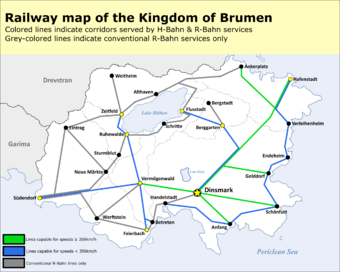Realm Railway Group of Brumen
This article is incomplete because it is pending further input from participants, or it is a work-in-progress by one author. Please comment on this article's talk page to share your input, comments and questions. Note: To contribute to this article, you may need to seek help from the author(s) of this page. |
 Logo used since January 1958 | |
Formerly | Brumen Rail (1930 - 1958) Waldreich Rail Company (1844 - 1930) |
|---|---|
| State Owned Company | |
| Traded as | FSX: RGBN |
Key people |
|
| Revenue | |
| Owner | |
Number of employees | XX,XXX |
| Subsidiaries | RGB West RGB East RGB North RGB South RGB Care RGB Property |
 | |
 Map of Brumen's rail network. | |
 A H-Bahn Blitz 3 train. | |
| Locale | |
|---|---|
| Dates of operation | 1844–present |
| Predecessor | Brumen Rail (1930 - 1958) Waldreich Rail Company (1844 - 1930) |
| Track gauge | 1,435 mm (4 ft 8 1⁄2 in) Standard Gauge |
| Length | 97,000 km (60,000 mi) |
| Headquarters | Dinsmark, Brumen |
The Realm Railway Group of Brumen (Brumenese: Reichsbahngruppe Brumen), commonly abbreviated as RGB, is a for-profit national state-owned railway company & operator in Brumen consisting of six subsidiaries. The Government of Brumen is the largest shareholder, holding 55% of the company's shares whereas the remaining 45% are publicly traded in the Anfang Stock Exchange. RGB maintains and administers the country's rail network and operates a fleet of train services through its subsidiary companies, operating both fleets of high speed (HSR) and conventional (non-HSR) rail services. Generally speaking, all high speed services in Brummen are referred to as the H-Bahn, whereas conventional rail services include the R-Bahn, U-Bahn & S-Bahn networks. Other services provided by RGB includes regional, commuter, rapid-transit & light rail networks. RGB Freight provides logistical & freight services for Brumen's industries whereas RGB Care provides maintenance for both its fleet of trains & infrastructure including tracks, stations & crossings. All major cities in Brumen are connected by both H-Bahn & R-Bahn services whereas smaller towns and cities are connected by R-Bahn services supplemented by U-Bahn & S-Bahn services for local services.
History
Early History
Decentralized Era
Privatization of Railway
Controversy & Bankruptcy
Consolidation & Nationalization
Company Structure
Brands
Blitz
Blitz trains (Brumenese: Lightning) is a brand and umbrella term that refers to RGB's fleet of H-Bahn trains and are also the most commonly used H-Bahn trains found in Brumen. All RGB subsidiaries operate H-Bahn trains under the Blitz brand, with the word Blitz itself used synonymously to describe Brumen's H-Bahn network. Blitz trains were originally envisioned to connect all realm capital cities with Dinsmark to promote and distribute economic, social & political development to the realms. In the modern era it is represented as the official flagship train of Brumen, categorized as the highest service of all rail networks in Brumen. Currently RGB operates two models of Blitz trains: the Blitz 3 with a service speed of 300km/h, and the Blitz 4 with a service speed of 380km/h. The first Blitz train commenced operations 1970 with a single corridor: the Dinsmark-Anfang line and was an immediate success. The Blitz trains, and H-Bahn network as a whole, represented a breakthrough in rail travel for Brumen. Its riders who were used to the slower and more economical R-Bahn trains were impressed by the Blitz trains consistency in delivery punctual departure & arrival times as well as its high level of comfort across all cabin classes. It is also the first train service whose fares are not subsidized by the federal government, proponents arguing that the higher level of comfort & service as well as the relatively higher operation & maintenance cost of the H-Bahn network justifies the high fares. Noting the Blitz and H-Bahn network's potential to distribute & drive economic growth across its constituent realms the federal government provided loans & subsidies for the construction & expansions of RGB's H-Bahn network. By 1980 all capital cities of each constituent realm were connected by a H-Bahn compatible rail network and served by Blitz trains. Blitz trains offer four types of cabin classes: First, Business & Economy classes. Fist class cabin seats are arranged in a 2+1 configuration whereas Business class arranged in a 2+2 configuration. Both classes offer welcome amenities such as welcome drinks that includes alcoholic beverages, warm towel, video on demand entertainment system and complimentary meal(s). Economy class seats are arranged in a 3+2 configuration with standard amenities such as blankets & basic toiletries (for overnight services) but must purchase their own meal.
R-Bahn
The R-Bahnm (abbreviation of Regionalbahn) is the umbrella term for all conventional (non-HSR) services operated by RGB. Because of this it is often considered as a hybrid train service that combines the characteristics of inter-city, local and commuter train services. It is also the only type of train service whose fare is partially subsidized by the government. When combined together, R-Bahn services represents the largest ridership and source of revenue of RGB and its subsidiaries. While H-Bahns enjoy a higher popularity amongst commuters due to its rapid service time it is more expensive and not everyone uses the H-Bahn on a daily basis. Most daily commuters would utilize various R-Bahn services to commute from their houses to work. H-Bahn networks are primarily used for commuters who live and work in two different cities, a smaller demographic compared to the rest of the workforce who typically live either within the same city or its suburbs and then commutes to the center of the city using an R-Bahn service. R-Bahns have been a pivotal part of RGB since the establishment of the modern railway era, and continues remains so in the present day. Modern R-Bahn trains are much faster and accommodate more passengers compared to those made in the early 2000s. The demographics of commuters have also shifted, previously before 2000 the largest user of hte R-Bahn service were the lower class of society due to its subsidized fares. However in modern times more people from the middle class have begun to utilize the R-Bahns, citing its increased reliability, quality of service & its cheap fares. The middle and lower class have become the two largest users of R-Bahn services, with a small bug significant number of upper class of society also utilizing it. There are however calls from within the government and the general public to end government subsidies for R-Bahn fares. Proponents for ending subsidy argues that subsidized fares were implemented during times of economic downturn of Brumen, whereas in the modern era most people including the lower class can afford to pay for non-subsidized R-Bahn fares. Opponents on the other hand argue that the government is bound by the country's constitution to provide subsidies, quoting article 15 of the constitution that states the government is obligated to provide a means for the country's population access to affordable public transportation. The debate continues to date.
U-Bahn
S-Bahn
Subsidiaries
| Business | Company Name | Logo | Operational Area | Remarks |
|---|---|---|---|---|
| Passenger | RGB West |  |
Largest subsidiary of RGB, operates the largest fleet of H-Bahn trains. | |
| Passenger | RGB North |  |
||
| Passenger | RGB East |  |
||
| Passenger | RGB South |  |
||
| Logistics | RGB Freight |  |
||
| Maintenance Services | RGB Care |  |
Networks
Assets
Rolling Stock
| Train Class | Image | Origin | Entered Service | Line | Power Type | Speed | Remarks | ||
|---|---|---|---|---|---|---|---|---|---|
| H-Bahn | |||||||||
| Blitz 4 |  |
2015 | TBD | Electric | 420 km/h (Record) 400 km/h (Design) 380 km/h (service) |
Used for long distance services | |||
| Blitz 3 |  |
1999 | TBD | Electric | 330 km/h (Design) 300 km/h (service) |
Used for long distance services | |||
| R-Bahn | |||||||||
| REX-5 |  |
2011 | TBD | Electric | 290 km/h (Record) 220 km/h (Design) 130 km/h (service) |
Used for medium & long distance services | |||
| REX-4C |  |
2002 | TBD | Electric | 160 km/h (Design) 90 km/h (service) |
Used for short & medium distance services | |||
| REX-4B |  |
2002 | TBD | Electric | 160 km/h (Design) 90 km/h (service) |
Used for medium & long distance services | |||
| REX-4A |  |
2001 | TBD | Electric | 160 km/h (Design) 70 km/h (service) |
Used for medium & long distance services | |||